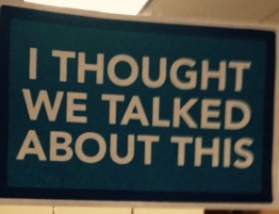
Seattle: Culture Change Leader
August 11, 2015
What’s Next in 2016 for JKB
January 7, 2016NEVER HAVE A SOLUTION BEFORE YOU HAVE DEFINED THE PROBLEM
BUT
IF YOU HAVE DEFINED THE PROBLEM, THEN YOU SHOULD ALSO
DEFINE A SOLUTION
One of my favorite business activities is participating in a problem solving meeting.
Every organization, be it for-profit or non-profit, has problems that they have to solve in order to move forward. In some cases, these meetings can be very stressful, and the problems that are being solved may be so significant the organization’s future is in jeopardy. One of my long time mentors once told me that “If it wasn’t for solving problems, we would not be needed as senior managers. In the world full of “Mega Data”, we can only hope that the computers don’t end up solving problems better than human beings, because then we would not be needed.”
The problem solving meeting can range from two people talking at a water cooler, to a formal meeting requested by a senior leader to talk about a specific issue or problem. In almost every case, most people want to talk about their solution to what they perceive to be the problem. My favorite position when I am in one of these meetings, is to listen to everyone talk about what they think we should do. Almost 100% of the time, groups define a solution before they clearly define the problem.
I listen to all of these conversations, asking myself one question: “What is the Problem these people are trying to solve?” About halfway through the meeting, I raise my hand and, having listened to many thoughts, I read what I believe is the problem that we are trying to solve. 50% of the solution to a problem is clearly defining the problem.
At the Boeing Company, not only do they work on defining the problem as the mandatory first step in their process, they ask “Why” this is a problem, before they try to define the solution. In fact in some cases they ask the “Why” question three levels deep: “Why” is this a problem, and then asking “Why” was that a problem, and then one more time asking “Why” was That a problem. You see, many times a problem is just the unintended consequence of solving a previous problem –
No matter what type of culture you work in, always:
Clearly Define the Problem Before You Agree On A Solution
There is a second activity that regularly happens in all organizations:
“People Love Telling Other People What They Think the Problem Is Around Here”
I think it is human nature to view the things that are happening around you, especially in the work environment, and see things that do not seem to make sense to you. We love a soap opera and we love second guessing other people’s actions. Part of this behavioral pattern is grounded in our own insecurities. This activity is deep seeded in an individual’s personal insecurity.
The cultural reverse issue to the defining a problem before you have a solution is:
“If You See A Problem, You Should Thoughtfully Define A Solution”
You can tell a lot about a culture by the way problems are identified, discussed and solved. Great cultures have lots of people defining real potential problems. Great cultures have individuals supporting the process and interaction of well-intended team members. Great cultures focus on how the problem solving impacts the mission and the desired outcomes. Great cultures rally around the execution of the solution based on the knowledge that once a problem is defined, discussed, considered via impact on the mission, and then decided on a solution, then everyone is “ALL-IN” on the execution of the solution.






1 Comment
Most often the easiest part of developing a solution is truly identifying exactly what the problem is. My experience is most people want to complain that this or that is “not right” and say it should be fixed. But how can you fix something if you don’t know what the problem is. Here is a great example. I am in commercial real estate. Someone called me and told me the temperature in their conference room was too hot and wanted it fixed immediately. Well, the problem is not that the temperature is too hot as this is the outcome but rather what is causing the temperature to be too hot. Could it be malfunctioning equipment, insufficient resources, poor circulation or any other of potential causes. After investing the situation the problem was caused by the firm having more people in the conference room than were planned for in designing the HVAC system; hence the solution was easy to implement…don’t overcrowd the conference room.